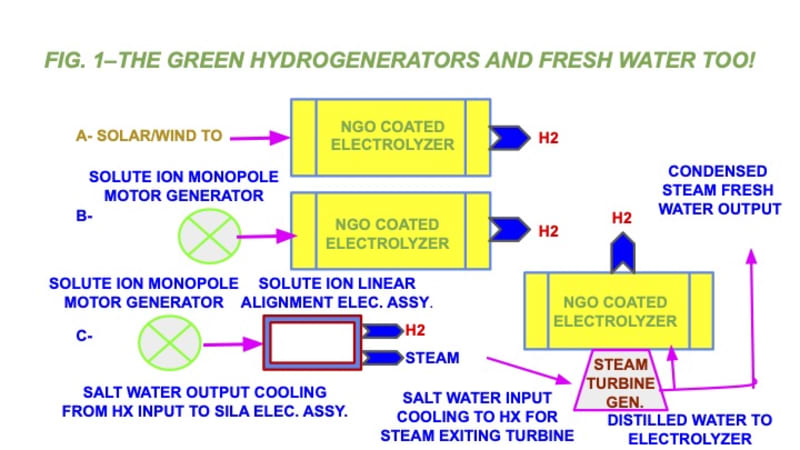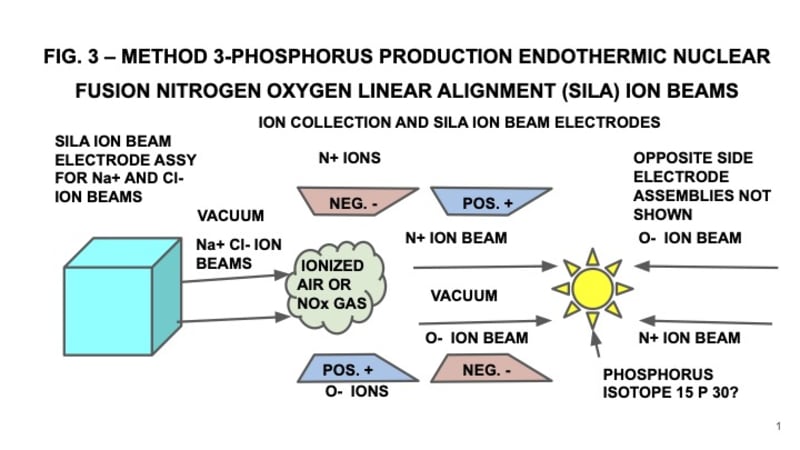FIG. 1: Two innovative concepts are provided:
(1) Nanographene Oxide-coated surfaces in an electrolyzer for H2 production
(2) Application of Coulomb’s Law electrostatic repulsion via solute ion linear alignment (SILA) ion beams to also produce H2 in a combined process with the NGO electrolyzer with both powered by solute ion monopole motor (SIMM) as 24/7 renewable power source with no CO2 emissions or excess power battery storage or grid access requirements.
Introducing 20% Nano Graphene Oxide (NGO) coating surface to both Electrolyzers and Fuel Cells showed the ability to reduce cost of hydrogen and energy production respectively by 67% of current market values. In addition, there is strong potential for reducing costs by 90% or higher of hydrogen production by increasing the percentage of NGO coating surfaces of the various components of Electrolyzers.
Additionally, SILA ion beams enable brackish water and sea water as the source of H2 while also producing much-needed purified desalinated fresh water to supply the NGO electrolyzer as well as dramatically alleviate drought conditions and groundwater depletion..
FIG. 2 Phosphorus Recovery for Agriculture via Solute Ion Linear Alignment Ion Beams Decomposition of Struvite, Dewatered Sludge and Sewage Sludge Incineration Ash
Method 1--Solute Ion Linear Alignment (SILA) heavy ion beams such as sodium and chlorine to impact precipitated struvite and ionize it so that it could be separated by electrodes. The material on negative electrode should contain P and other positive ions. Collected ions on the electrodes can also be subject to linear alignment to generate ion beams that pass through a magnetic field. This should enable separation on a target due to unique mass and charge of each different type of ion. It is believed this would result in pure phosphorus.
Method 2--The same approach of ionization via heavy ion beams such as sodium and chlorine and magnetic fields might also be applicable to Dewatered Sludge and Sewage Sludge Incineration Ash.
FIG 3 Method 3--
Phosphorus has an atomic number of 15 and an atomic weight of about 31 gms/mol.
Nitrogen has an atomic number of 7 and an atomic weight of 14 gms/mol.
Oxygen has an atomic number of 8 and an atomic weight of 16 gms/mol
Utilizing the approach shown in this website of endothermic nuclear fusion, it may be possible to produce an isotope of Phosphorus 15 P 30 by similarly separating a gas such AS AIR (78% NITROGEN 21% OXYGEN) OR NOx via heavy ion beams such as sodium and chlorine thereby forming N+ and O- ion beams that could be caused to intersect and fuse into the Phosphorus 15 P30 isotope. Thereby, very common substances such as nitrogen and oxygen readily available from air could be used to form phosphorus.
http://contest.techbriefs.com/2021/entries/Electronics-Sensors-IoT/11174
Of course, it would still be desirable to separate phosphorus from the waste streams to prevent discharge into the oceans to prevent algae blooms, etc.
References:
WO2022/271757A1
https://strategy.asee.org/experimental-testing-of-the-proton-change-membrane-pem-hydrogen-fuel-cell-performance-with-nanographene-oxide
http://contest.techbriefs.com/2022/entries/sustainable-technologies-future-energy/11706
See links 2021 Electronics-Sensors-IoT; 2020 Medical; 2014 & 2012 Sustainable-Technologies entries
US 8,925,294
ASME ES-2010-90396;
SPESIF-2012 dielectric analysis torque;
ASME IMECE-2016-65930
Like this entry?
-
About the Entrant
- Name:Anthony Fresco
- Type of entry:teamTeam members:
- Prof. Hazem Tawfik PhD








